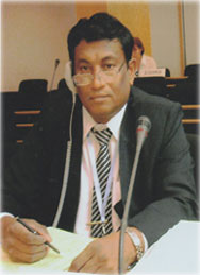
At the 6th Meeting of the ASEAN Expert Group on Communicable Diseases (AEGCD) held in November 2011 in Yangon, Myanmar, Dr. Soe Lwin Nyein, Professor and Director of Epidemiology, Department of Health, Ministry of Health, Myanmar, was confirmed as the 2012 Vice Chair of ASEAN+3 FETN. We were able to congratulate him in person and sit down for an exclusive interview while he was in Bangkok for the Fourth Regional Meeting on the Implementation of the International Health Regulations (2005).
How did you get into epidemiology?
My previous ambition was to be a specialist of Obstetrics and Gastroenterology. From 1982 to 1989, I was working for a private clinic in a remote area. In 1989, I volunteered for government service. I did this based on a positive attitude, wishing to help the public. In the Station Medical Hospital, there were 16 beds for the clinic and public health cases, such as malaria and diarrheal cases.
In 1990, there was a big outbreak of severe diarrhea. I read books on epidemiology to attempt to prevent and control this issue. Within one week, along with the help of the Red Cross, we focused on clinical management, prevention and control. There was a total of 200 cases, 50 had diarrhea and shock. There were only three staff members and the Red Cross.
Then, the Central Epidemiology Unit from the Ministry of Health came, did the outbreak investigation and management and gave their report. Vibrio cholerae 01 came from afar. The source was 12 miles away and patients were watched closely. It turned out the stream that flowed from this source was the culprit. I thought, “How did they know the source?!” I wanted to be able to track the source too! This ability was important in prevention and stopping the outbreak. Cholera was controlled. With this little knowledge, I can save lives.
What is the status of field epidemiology training in Myanmar?
Since 1999, there have been plans to conduct an FETP. Originally, we wanted to have a 3-month program that involved three rotations of 2 weeks of theory and 2 weeks in the field. The trainee would then be expected to return to their respective workplace to use lessons learned. It was more practical to have a 3-week short course focused on scenario-based training. Since 2008, 163 medical doctors, veterinarians, health assistants, town nurses and public post-graduates from the University of Public Health have received training.
The Health Training Center is located in the Mandalay Township, Sinywagyi Village, which is located 20 minutes from the Divisional Health Department and a 3-hour drive from Naypyitaw. The Health Training Center was provided by the government in 1996 and has recently been renovated. There is rural health clinic, an office, classroom and two wards that can hold total (60) (ie.30 females and 30 males). The location allows for us to work in this rural village, where we go out to assess and control outbreaks as well as provide prevention methods to the community.
I also teach a field epidemiology course at the University of Public Health. I am also the focal point for epidemiology, surveillance, response, disaster management, IHR zoonotic diseases and EPI. We use local resources for this training course and have previously received teaching materials from MBDS. I would like to strengthen the capacity of staff by the support of the Ministry of Health and WHO and other partners.
Where do you see field epidemiology training in Myanmar in 5 years?
Internally, the program here would be strengthened to a 3-month course whereby graduates receive a certificate. Then, expand the program to 6 months and graduates receive a diploma. A goal is to become a WHO Collaborating Centre. For long term quality, we would send trainees to a 2-year international FETP to get quality trainers.
How can Myanmar contribute to the objectives and strategies of ASEAN+3 FETN?
We can successfully implement the strategies and we are ready to support in every point of view. We have much expertise in field epidemiology training, outbreak investigation and response, and malaria. Myanmar would like to become a lead country and our interest to become the Vice Chair for 2012 came from the AEGCD Meeting.
What issues would you like to see ASEAN+3 FETN address over the next five years?
Because there are so many threats, the only solution to solving those problems must be to strengthen the field epidemiology training network to improve capacity, information sharing and resource mobilization. The goal is to save lives and prevent socio-economic loss. We should also try to collaborate with other regions to promote cooperation and collaboration.
